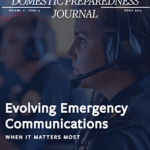Imagine this scenario. A tornado watch has been in effect for the past six hours. The severe thunderstorm warning expires as the squall line passes over the area, which escaped significant severe weather. Although the Storm Prediction Center shows the area has been downgraded from enhanced to marginal, the Day 4-8 prediction indicates a 15% chance of severe weather in the area on Wednesday – today is Friday. Here comes another one.
Midwestern, Southern, and Southeastern emergency managers experience extended severe weather threats during the spring and early summer months. Coastal emergency managers and certain inland emergency managers must keep an eye on the hurricane threat, especially during the peak of hurricane season, which usually starts in August. In addition, Southwestern, Midwestern, and Northeastern emergency managers are often frequently under great pressure for winter weather.
Weather threats are exhausting – especially when the forecast is ongoing. As such, emergency managers need to know what to do to reduce weather anxiety. Following are several ideas – some more concrete than others:
- Truly understand the potential impacts of weather on the community. Develop strategies to reduce the impacts. Ensure that executive leadership understands the potential impacts, and supports the response and continuity efforts.
- Minimize new initiatives and programs during known inclement and severe weather seasons. Planning a new “roll out” or large symposium increases the stress level when severe weather looms.
- Exercise – tabletops, drills, and functional exercises designed to increase preparedness and reduce impacts will be very beneficial when the storm hits. Physical exercise also is a great stress reducer.
- Build collaborative relationships with the people responsible for the aftermath of storm damage. Know the people who clear the snow and ice, or clear debris from the roadways. Meet, and sometimes just visit, with them frequently – not just when a storm is approaching. Knowing they are prepared and available will make the emergency manager’s job far less stressful.
- Trust – have a good relationship with the executive who makes weather-related decisions. This person understands that weather if fickle and often unpredictable.
- Regularly focus on continuity. Emergency managers cannot stop a storm, but they can develop effective strategies to reduce the impacts after the storm. Knowing that there is a plan (and back-up plan when relevant) for power outages, debris removal, food service, etc. eases the stresses that come with the job.
- Have a family plan. For example, needing to “pick up the kids after school” just after the National Weather Service (NWS) issues a weather bulletin is extremely stressful if there is no back-up plan.
- Build resource capacity to meet the threat – snow/ice removal equipment, generators, chainsaws, food, etc. all provide the emergency manager with a certain level of comfort.
- Spend extra time, effort, and resources with key stakeholders (e.g., residence life/housing on a campus) to make sure they are prepared for the aftermath of storms.
- Participate in the NWS’s Storm Ready Program. For either a community or campus, this certification through the local NWS office is an excellent way to review, improve, and standardize severe weather preparedness and response procedures.
- Develop a good relationship with the local NWS office. It certainly inspires more confidence in a forecast when the senior leadership team knows that the weather forecast came directly from the NWS versus a weather app on a phone. Each NWS office offers a variety of products that are designed to equip county, local, and campus decision-makers with reliable and current weather forecasts.
- Have a back-up weather-monitoring plan – as funding permits – using a private weather service vendor or a local weather station. Although the NWS should be the standard for communicating weather watches and warnings to the community, private weather providers and local weather monitoring stations are excellent tools to provide another source of information in order to supplement NWS forecasts. Additionally, special events (e.g., outdoor concerts, sporting events, festivals, commencement) may require an additional level of specialized forecasting for lighting monitoring, wind speeds, and precise storm tracking that vendors and local weather stations will likely be able to provide.
- For emergency managers on a college campus or those who live in or near a college town, check to see if there is a geography and/or atmospheric sciences program. Such programs may offer access to several meteorologists on campus who can provide local weather monitoring forecasts.
- Test the emergency notification system. Many community members rely on outdoor warning sirens and other emergency notification phone/text systems for their primary notification method for severe weather warnings. Having emergency notification systems that are well maintained (outdoor sirens), are tested frequently, and have high levels of participation (phone/text systems) can reduce stress for emergency management professionals during periods of severe weather.
- Test the emergency operations center (EOC) by activating either virtually or in person by having appropriate personnel respond to the actual EOC site. Many personnel may know that they are required to be part of an EOC during a weather emergency, but a large number may not know their roles or responsibilities once they respond. Partial and virtual activations may be ideal for severe weather monitoring situations.
- Continue to educate members of the community about the importance of having family emergency plans and emergency kits as well as knowing which types of severe weather can impact them. If these preparedness actions are embraced by members of the community, it can help reduce the number of 911 calls, which then decreases the need for public safety resources for non-life-threatening response calls during severe weather.
There is little doubt that severe weather causes anxiety for emergency management professionals. It is not enjoyable to receive an email from the NWS indicating a special weather webinar is scheduled for Saturday at 2 p.m. due to the potential for severe weather in the area. Hopefully, several of the tips included above can possibly reduce some of that anxiety and build confidence among senior leadership team.

Andrew (Andy) Altizer
Andrew (Andy) Altizer has over 20 years of emergency management planning experience and another 10 years of planning experience in the military. He is the emergency preparedness coordinator for The Westminster Schools and a Criminal Justice instructor at Georgia State University. Previously, he was the director of emergency management at Kennesaw State University and director of emergency preparedness at Georgia Institute of Technology. He also served as the critical infrastructure protection program manager at the Georgia Office of Homeland Security. In the U.S. Army, his roles included inspector general, public affairs officer, artillery commander, and plans and operations officer.
- Andrew (Andy) Altizerhttps://domesticpreparedness.com/author/andrew-andy-altizer
- Andrew (Andy) Altizerhttps://domesticpreparedness.com/author/andrew-andy-altizer
- Andrew (Andy) Altizerhttps://domesticpreparedness.com/author/andrew-andy-altizer
- Andrew (Andy) Altizerhttps://domesticpreparedness.com/author/andrew-andy-altizer

Steve Harris
Steven (Steve) Harris is the director of the Office of Emergency Preparedness and Insurance and Claims Management for the University of Georgia. Previously, he served as the State School Safety Unit manager with the Georgia Emergency Management Agency – Office of Homeland Security (GEMA). He has also served as a police officer and as an assistant security administrator of a school district. He graduated from Georgia Southern University with a degree in history and continued his education at The University of Georgia by receiving a master’s degree in social science education. He has worked in public safety for 24 years and holds a Professional Emergency Manager certification through the State of Georgia.
- Steve Harrishttps://domesticpreparedness.com/author/steve-harris






